#Niche Marketing Refers To
Explore tagged Tumblr posts
Text
tranquility base hotel + casino concept ads because i love this album more than anything and i have an incurable urge to create:
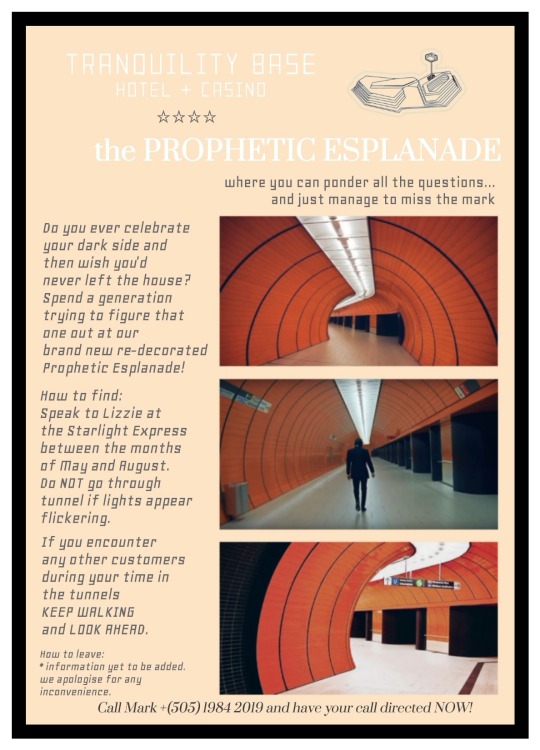

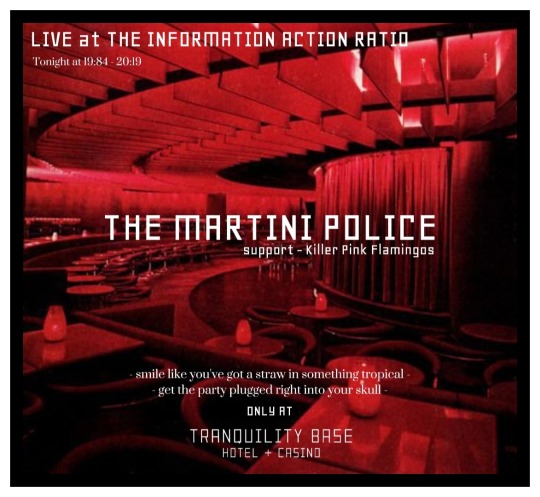


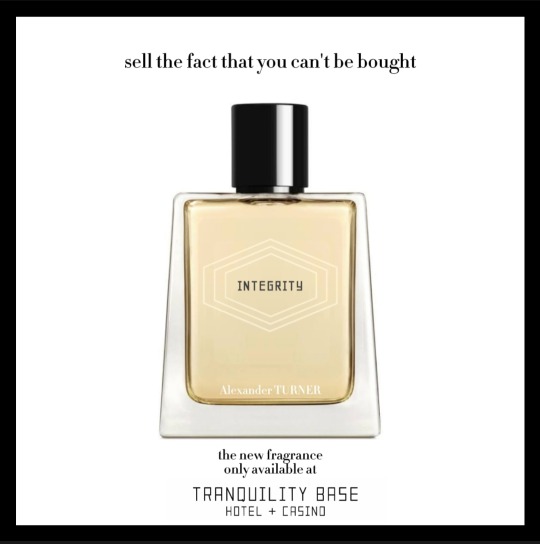
inspired by!!: x - x - x
#gotta love that undercurrent of unease#and ofcourse a million lyric references#i never took graphic design in school. so please be nice 😭#ITS NOT EVEN MY FAVOURITE AM ALBUM IT JUST- UGHHGGGGGG#its got such a grip on my soul its actually insane#also love how literally NONE of these would make sense to anyone outside of a very niche market audience-#am. thankyou for blessing us with this album.#and thankyou to anyone else whos ever made anything based on tbh+c because you lot literally fuel my soul#tbh+c#tbhc#tranquility base hotel and casino#alex turner#arctic monkeys#am6#my posts!!
365 notes
·
View notes
Text
i just feel like etsy witches are an untapped source of political power both meaningfully and nonsensically. i do believe this to be true
#its funny asf to me. u can make billionaire spells and womb barren curses and hexes and jinxes and wat not#u can trap a djinn in a twenty dollerrrr ring from the flea market but u CANT put a blood curse or two men? maybe more#idkkkkkk#sounding fake as fuck... or maybeee they're just not properly motivated idk#if i make a niche early 20th century ocCULT reference will u guys me mad 🥺
2 notes
·
View notes
Text
Xafanian economic theories eventually made their way to the Soviet Union, where they were met with a mixture of derision and confusion. Broadly speaking, the idea of treating the market as a transcendent mind, capable of making descions and exerting will, was incompatible with Marxist economics.
Few writers even dedicated the time to respond to Xafa's work. In fact, the brunt of soviet responses came from local state-sponsored humorist columns, who mocked Xafa's meandering theoretical writing, and frankly strange greco-american jingoism. Even the title "A Theory of Hypnoeconomics" was mocked by satirist Fyodor Babkin as "a fitting name, as it requires being asleep to believe."
This is not to say that criticisms of Hypnoeconomics were popular. The reality is quite the opposite. The heyday of Xafanian economics were highly specialized. Most Soviet citizens were not even aware of such a niche writer, much less any mockery of her work.
This changed during the Regan years, with the widescale roll out of Hypnoregulatory practices. Soviet intelligencia had a veritable field day. To quote Babkin:
"The state religion of America has always been money. Now, they can afford to pay a priesthood."
The concept was even mocked in a popular Russian sitcom Sashka, in which the titular foul-mouth jokes:
"Take a piss on that [nonsense, referring to hypnostimulant JVH-1], does it make you "One with the toilet?""
However, this came on the back of more significant criticisms. More than nineteen Soviet economists collaborated on an internal documentation, recently declassified, detailing their research into hypnoeconomic practices. These are notable, in that they do not engage with the parapsychological elements of Hypnoeconomics in the least. Their criticisms are strictly material.
"The poor are still poor, the bourgeois still bourgois. Small market collapses have still occured, and while the Americans call this intentional, these claims are unfalsifiable. By any material measure, the Hypnoeconomics program is a profound waste of money, resources, and capital. Any potential benefits to market analysists enhanced with mind-altering substances are hampered in that their regulatory arm ultimately answers to existing financial apparatuses of bourgeois power."
This sentiment was perhaps better summarized by Babkin:
"If the Americans did have psychics who could predict the stock market. They would not listen half the time."
1K notes
·
View notes
Text
Writing Notes: 10 Uncommon Magic Systems

These examples of unique magic systems might pique your curiosity and inspire your next fantasy epic.
Color Magic: Harnessing colors to invoke specific spells or effects.
Sound Magic: Crafting spells through vocal tones, vibrations, or musical instruments.
Time Magic: Manipulating the past, present, or future, often bending the laws of physics.
Egoic Magic: Altering one's sense of self or emotions to use as a magical conduit.
Manufactured or Artificial Magic: Magic crafted or produced through synthetic means (e.g. via objects or alchemical processes).
Nothingness Magic: Conjuring voids or vacuums, often manifesting as spatial anomalies.
Glass Magic: Manipulating glass to create barriers, projectiles, or even complex machinery.
Astrology-Based Magic: Drawing powers from celestial bodies or zodiac signs.
Fate Magic: Influencing destiny or chance to manifest predetermined outcomes.
Bio-magic: Utilizing biological processes or traits for supernatural effects.
Incorporating lesser-covered categories of magic can set your story apart in an oversaturated market, helping you carve out your distinct niche and voice. Source
More: On Fantasy ⚜ Writing Notes & References Writing References: Worldbuilding ⚜ Plot ⚜ Character
#on writing#fantasy#worldbuilding#writeblr#writing inspiration#writing ideas#writing inspo#creative writing#writing prompt#magic#writing advice#writing tips#light academia#dark academia#writing reference#nc wyeth#realism#art#illustration#writing resources
330 notes
·
View notes
Text
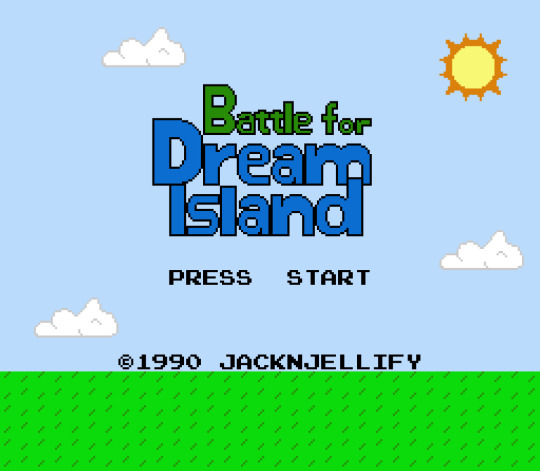
Has anyone ever heard of “Battle for Dream Island” (1990) before? Really obscure NES game, doesn’t even have a Wikipedia page (or hell, even a mention in one).
From what little I can find about it on the internet, Battle for Dream Island was an NES game released on January 1st, 1990, apparently made entirely by a pair of independent American developers. Never made all that many sales, but eventually it garnered a rather niche following on an obscure gaming forum, though it had long since dissipated. Unfortunately, seemingly nothing from the forum threads was archived, so all I have to go on are a few vague threads titles from a navigation page.
I, rather cliched like, bought this BfDI cartridge from a sleazy old guy at a flea market (along with Puzznic and Wario’s Woods for a bargain deal). I dumped the ROM and booted it up on an emulator to take some screencaps.
Upon pressing start, you are prompted to “Choose Contestant,” and have a choice between any of 20 playable characters (who are all everyday objects, for some reason). Each contestant has their own stats, and while you can feel the difference while playing, the overall impact of character choice is pretty negligible. (Also some of these guys don’t even have arms?? Weird design choice but okay.)
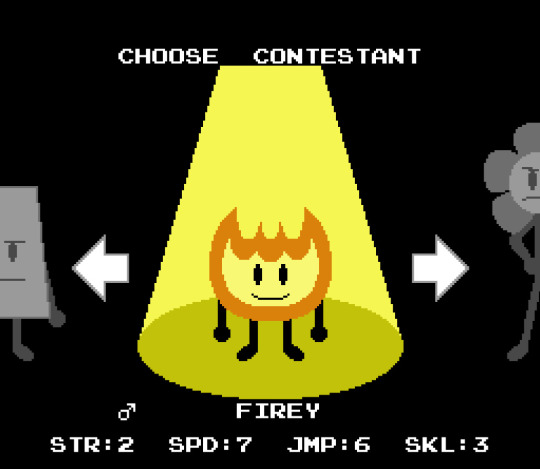
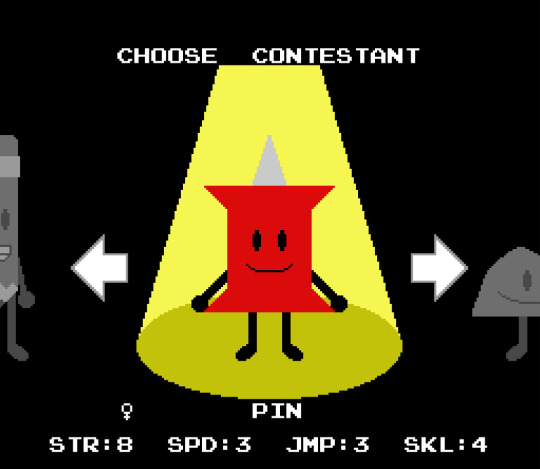
Two screencaps of the character select screen. I went with Pin for my first playthrough cause idk she seemed kinda cute. I’m almost sure the stats are “Strength,” “Speed,” “Jump,” and “Skill.”
(Continued under cut)
While touting itself as a game show, BfDI is essentially a glorified minigame collection. The gameplay loop is as follows: You and the 19 other contestants play a minigame (referred to as “challenges”) to earn points based on how well you do (though I’m fairly certain the computer contestants just get a random amount of points for each challenge). Most of the challenges are various platforming segments, though some others fall more into puzzle game territory.

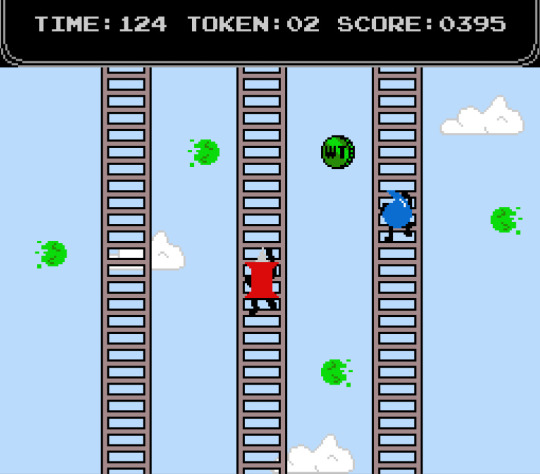
Two of the challenges. The green “Win Tokens” can be collected for bonus points. LEFT: A horizontal platformer level. The grey wall in the middle of the screencap moves up and down. RIGHT: A challenge about climbing ladders while avoiding “acid spitballs.” The game pauses to scroll vertically a la Super Mario Bros. 2.
After each challenge, this speaker thing shows up (pretty sure he’s supposed to be like a game show host?) and tallies up everyone’s score. The contestant with the least score gets “eliminated” and removed from the game.


The results screen. Leafy did rather poor on the last challenge, so she’s out of the game.
The game continues like this until you lose (have the least amount of points) and get booted to the game over screen, or until you are the last one left, in which case you win Dream Island! (Though of course in reality you just get booted back to the title screen. No Dream Island for you.)
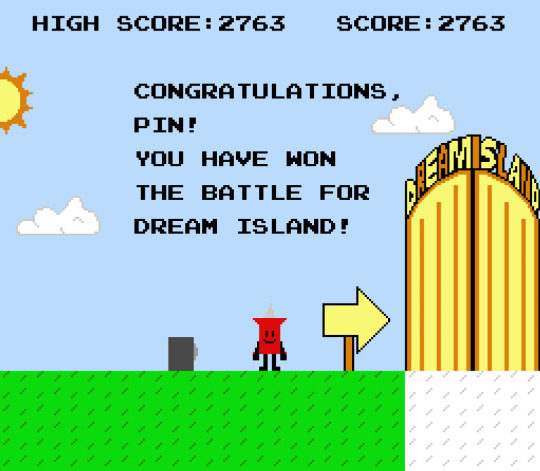
The victory screen, with the gates to Dream Island in sight. Feels more like the gates to hell given how Pin’s staring at me.
It’s a fairly easy game for NES standards (I won on my first try). Took me about 80 minutes on my first playthrough, though subsequent ones could take less than an hour as I knew what I was doing. The brevity and the fact it saves your high score gives BfDI a nice sense of replayability (though this is probably best done sporadically, as the challenges tend to get a bit samey after a couple of back-to-back playthroughs).
So yeah, just wanted to share this in case anybody else has heard of it. I’ll probably rip the sprites and upload them sometime later cause it doesn’t look like anybody’s done that yet.
#bfdi#bfdia#bfb#tpot#bfdi firey#bfdi pin#bfdi leafy#bfdi needle#bfdi teardrop#bfdi eraser#bfdi flower#bfdi pencil#bfdi rocky#bfdi announcer#BfDI1990#unreality#unfiction
293 notes
·
View notes
Note
I’ve got a question about packing- so I know some packers can be used as dildos as well (at least that’s what my high school trans friends said) so my question is- can *every* dildo be used as a packer? Or is it like- some packers are dildos but not all dildos are packers. I’m messing around with my gender identity and just trying to have fun with it. I’d like to wear my 9 inch sparkly pink n blue dildo out but im not sure if there’s a difference in the way packers lay in the underwear vs dildos. Sorry if this is convoluted ahsjfjsk I always talk too much
hey yeah this is a good question. this gets somewhat detailed and has a lot involving sex and masturbation for ftms so putting the rest under the cut.
so packing as an actuon is generally divided into two catagories, soft and hard packing.
usually when people talk about packing they mean soft packing. If packing in general is the action of inserting an object into your pants to create the illusion of a penis- soft packing would be creating the illustion of a soft or flaccid penis. this is for everyday use. this type is usually unoticable and can aid with passing or just be affirming for a person. This can be a sexual act but it’s most often a nonsexual act. When you look for packers, they’re usually made for soft packing. So they will be of a soft material and usually smaller. You can’t really penetrate with them because they are 1) much softer than a dildo and b) usually don’t have a lot of usable length. They’re not designed to have penetrative sex with. It’s also why people use socks or another soft object. You are simulating a flaccid penis.
The other type is hard packing. You are simulating an erect penis. So generally, you would use a dildo for this. However. because you are purposely putting an object that resembles an erect penis into your pants, it will look like you have an erect penis in your pants. There aren’t a lot of packers sold for this specific purpose, so you would usually just use a dildo. This is pretty much exclusivly for sexual use. Not always ‘i am going to have sex’ but if you are going to go somewhere purposely looking like you have a very noticable and very large erection, that more often than not will be for some sort of sexual purpose, whether it be exhibitionism/humilation, crusing or signaling to others you want to have sex or whatever else you may want to with it. I’m sure there are exceptions. but that’s the basic idea.
essentially if the object resembles a flaccid penis in softness, shape and size, that’s soft packing. if the object resembles an erect penis in softness, shape and size, thats hard packing.
What your friends were describing could be a few things. the first is often refered to as a 2-in-1 or 3-in-1 (or however many features it has) prosthetic. These are pretty special in a few ways. They are 1) usually on a spectrum from pretty realistic to ‘holy shit that’s not an actual penis attached to your body??’ 2) extremely expensive 3) handmade and often made to order 4) a very niche market and often seen as less of a sex toy or gender affirmation object and more of a.. bottom surgery replacement. they are very cool and very intense. There’s differences between different brands but generally it is one object that performs a variety of different functions based on how you wear it and different inserts. For example, someone may buy a prosthetic that claims to be capable of four whole things! Packing, Peeing, Sex and Masturbation. Packing: You put it in your pants. Depending on things you may use a harness or an adhesive to attach the prosthetic to your skin (which can look pretty seamless and last for days at a time which is pretty awesome) Peeing: You may use a stp (stand-to-pee) harness for this part but a prosthetic with stp capabilities is indeed hollow and acts as a funnel so you can indeed pee standing up. Sex/Masturbation: These often come with stiff inserts you put inside of the hollow stp cavity. These make the penis erect and sometimes have a stimulation area at the back of them so the part that presses agaist your genetalia can be stimulated during motions of thrusting/jerking. Some can even ejaculate! it’s pretty neat. But those are generally the things people talk about when talking about packers you can use as dildos. There are many variations of prosthetics that can and cannot do different things, I only really described one function. There are also bendable dildos and dual density dildos- but listen to me. silicone is great, but it can only do so many things. Things it cannot do is shrink in volume or change firmness. So while you could pack with a bendable dual density dildo, it will look more like you have a bent erection or at best a semi than it will a flaccid penis. If that’s what you’re going for, that’s great. But prothetics tend to go the route of a removable stiff insert for a reason.
I hope this made some sense. tldr. good luck and do whatever you want forever! however. packing with a 9 inch hard dildo is going to look like you have a 9 inch hard penis. do with that what you will.
152 notes
·
View notes
Text
A part-time job in the fast food industry was more than overdue. Truly, most of your friends had already had one in high school. You somehow managed to make it through college before needing one. But the real world is scary, the job market is fucked for your degree. That's how you end up at the fast food restaurant counter, saying you had an appointment with someone. And in his crisp white button-down steps out
Manager! Daniel, whose fingers linger a bit too long on yours as he gives you a pen to write down your credentials
Manager! Daniel, that's always cracking jokes and feels good when you play along or get his niche references
Manager! Daniel, that thinks you're innocent until he overhears you gossiping to your coworker about how you're notoriously not satisfied with your sex life
Manager! Daniel messing with you about a forgotten item of yours that's in his office. He lifts it up over your head with his long arms, and that's how you end up sharing your first kiss
Manager! Daniel ordering your new seasonal uniform a little bit smaller on purpose, loving how the tight fit looks on your thighs and chest
Manager! Daniel feeling you up in the walk-in, the break room, in the staff toilet once. Especially when he's jealous of the other men around, he pinches your nipples until they're pointy and makes you go out braless
Manager! Daniel straight up eating you out in the first drive-through window. Your work jeans down, he's under your apron, appraising how you talk to customers. Has to remind you to be quiet because you have headphones on and you're talking to the person giving out the orders. When there's no cars, he takes the headphones himself, telling his staff he's gonna test you. This actually entails listening to you beg for him to let you cum
Manager! Daniel making you work for your schedule changes. In reality, you both know it's his colleague that handles the shifts. But that doesn't stop Danny from making you earn it. If you sucked his cock nicely enough, you wouldn't have to do so many opening shifts in a row
Manager! Daniel driving everyone home after closing at around 2 in the morning. Of course, he drops you off last, only letting you get home after a quickie in the backseat. That way you can be as loud as you want
Want more of him? Hop into my inbox and let's talk
#f1 x reader#f1 smut#f1 x you#f1 imagine#daniel ricciardo x reader#daniel ricciardo x you#daniel ricciardo smut#manager! daniel
97 notes
·
View notes
Text
The Epitaph of Anything Goes

I decided that this morning I would talk about The Museum of Anything Goes and the subject of lost media.
For the uninitiated, The Museum of Anything Goes is an obscure "game" released in 1995 by Wayzata Technologies, a company that is so far under the radar that I was unable to find any useful information about it outside of TMoAG.
All I could uncover is that they published a few multimedia projects (which are essentially lost now) alongside some asset discs (clipart, SFX, etc.). That's it.
The brains behind Wayzata are even more difficult to locate these days: there are only two main names credited inside of TMoAG - Michael Markowski and Maxwell S. Robertson.
The game alleges that Michael and Maxwell are well known in the art world, but any additional information about the duo is scarce beyond the confines of the museum. Attempting to search for either name online turns up plenty of rabbit holes - but none of them have anything to do with the Michael and Maxwell responsible for TMoAG.

This is particularly fascinating because it essentially means that TMoAG is the only accessible record of their lives. Before we dig any deeper into that statement, let me step back and actually address what this game is.
The Museum of Anything Goes is, by definition, a virtual art museum. Functionally it's a prerendered point-and-click adventure game where you can explore a bunch of multimedia exhibits that give the surface-level impression of a children's edutainment game, but once you start exploring further it reveals a side that firmly plants the game's feet into a haze of substance abuse and surreal humor.

Many exhibits are essentially just toying around with the astonishing new powers of CD-ROM. Everything has to make noise. Everything has to spin and flitter around. There's an air of genuine excitement for the medium, and I can't help but find it extremely charming.
The game also functions as a scrapbook, filled to the brim with photos of random trips to the zoo and snow-mobile rides with friends. At one point we even get insight into something as specific as Michael's one-year job as a tutor at a Chicago middle school, where he talks about how it opened his eyes to how poorly funded and mismanaged the school system is.
It's simultaneously quaint and chilling to see so much personal history packed into a world doomed to obscurity. As I explore the deeper parts of the museum, I contemplate if the creators are still alive today. It's a bit morbid, but imagine that - you create a single obscure game with your friend and it's all the world can see. TMoAG is currently the only surviving piece that gives any insight into who these two men were.

While many exhibits are lighthearted or nonsensical, there are occasional moments where the game dips into the eerie.
One exhibit has the player kill a man by dropping him from the sky, and after burying him you open the coffin to a video of a rotting pig carcass being put into an incinerator.
Other exhibits just feature simple 3D renders shifting around a dark screen while haunting groans play in the background.
While I would never refer to the game as "scary," its darker moments combined with the occasional mature subject matter definitely begs the question: Who is this game for?
You have to remember that this game came out long before the concept of "alt-games" had become codified in the digital space. Sure, unconventional digital art had been around before the advent of 256 colors, but TMoAG was being sold on disk as a game! It came out 2 years after DOOM hit shelves!
The trend of using the PC for entertainment was certainly on the upswing around that time, but It's not like TMoAG had a massive audience to find a niche in. With its mature themes it certainly wasn't suited for the kids market either, so who was it for?
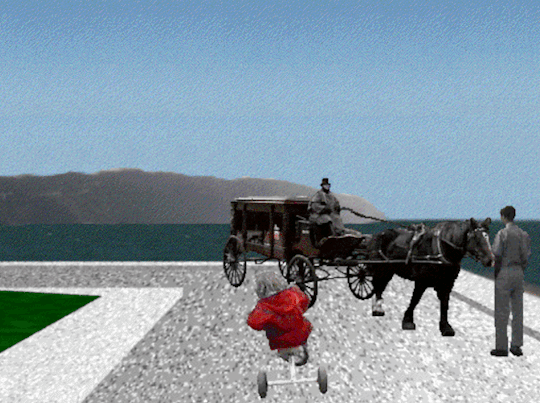
At the end of the day, it's a moot question. We already know the target audience for The Museum of Anything Goes: Nobody. It doesn't have an audience because by its nature, TMoAG wasn't being made FOR someone, it was being made BY someone. It's a raw, unfiltered form of personal expression.
I think games like these are pivotal, because they question why people assume a game has to exist for the sake of being a consumable product. TMoAG certainly has the shape of a product: it features an intro cutscene, it has a tutorial, it features intuitive UX, it even has a map! These are all features that are solely integrated to provide comfort to an end-user. But once you actually wander around the museum for a bit, you realize how bizarrely its packaging fits its contents.

I think TMoAG is criminally underrated. It's not because its core content contains some earth-shaking truth, it's because the game defied all odds and cheated death.
How many thousands of other personal projects were deemed a little "too exotic" to be archived? How much history was lost these past 40 years as the digital space evolved and ate its old skin?
God knows how many other TMoAGs we'll never learn about because they weren't lucky enough to be preserved.
The Museum of Anything Goes isn't just some nonsensical art piece, it's a grave marker for so much lost media. Its existence is a reminder that some people's lives were fossilized, then macerated into nothing because a construction company built a skyscraper over them. The only evidence we have of those other games existing is this little fossil that somehow slipped out from under the skyscraper unscathed.
Even though so much has been lost, TMoAG survives as an epitaph.
1K notes
·
View notes
Text
Book Review- The Wealth Elite: A Groundbreaking Study of the Psychology of the Super Rich, by Rainer Zitelmann Notes
I came across this book because I was looking for psychology books. I found the first of the book rather boring and too textbook-y. The second part is much better.
The author interviewed like 45 millionaire - billionaires. These were his findings.
—
48% stated that real estate was an ‘important’ source of their wealth, and one in ten described real estate as the ‘most important’ aspect of their personal wealth-building. And a total of 20% described stock market gains as an ‘important’ factor in wealth-building, although in this case only 2.4% stated that this was the ‘most important’ factor in building their wealth.
‘Creative intelligence’ is key to financial success. The following is a comparison between the percentage of entrepreneurs (and in brackets the percentage of attorneys) who agreed that the following factors played a decisive role in their financial success: seeing opportunities others do not see: 42 (19); finding a profitable niche: 35 (14).
The role of habitus
* Intimate knowledge of required codes of dress and etiquette
* Broad-based general education
* An entrepreneurial attitude, including an optimistic outlook on life
* Supreme self-assurance in appearance and manner.
He identifies a key quality that is essential for any prospective appointee to the executive board or senior management of a major company: habitual similarities to those who already occupy such positions.
Skillset of Entrepreneurs
* The ‘conqueror’. The entrepreneur has to have the ability to make plans and a strong will to carry them out.
* The ‘organizer’. The entrepreneur has to have the ability to bring large numbers of people together into a happy, successful creative force.
* The ‘trader’. What Sombart describes as a ‘trader’, we would more likely call a talented salesperson today. The entrepreneur has to “confer with another, and, by making the best of your own case and demonstrating the weakness of his, get him to adopt what you propose. Negotiation is but an intellectual sparring match.”
Entrepreneurial success personality traits
* Commitment
* Creativity
* A high degree of extroversion
* Low levels of agreeableness
Entrepreneurial success personality traits
* Orientation towards action after suffering disappointments (the entrepreneur remains able to act, even after failure)
* Internal locus of control (the conviction “I hold my destiny in my own two hands”)
* Optimism (the expectation that the future holds positive things in store)
* Self-efficacy (the expectation that tasks can be performed successfully, even in difficult circumstances).
constant power struggles with their teachers in order to ascertain who would emerge the stronger from such confrontations.
Secret of selling
* Empathy
* Didactics
* Expert knowledge
* Networking.
Conscientiousness is the dominant personality trait. Extroversion is also very common among the interviewees. Openness to Experience is very common
A high tolerance to frustration is one of the most characteristic personality traits of this group.
exceptionally high levels of mental stability.
primarily characterize entrepreneurs as being prepared to swim against the current and make their decisions irrespective of majority opinion.
“No, I never did that (lost my temper). I never get loud. But I can be resolute and say: “That is unacceptable.” And then you either have to go your separate ways or make a decision that the other party might not like. It’s the same in negotiations. I was always described by other people as a bit of a toughie.”
Having the courage to stand against majority opinion is probably a prerequisite for making successful investments, as this is what makes it possible to buy cheap and sell high.
Many of the interviewees spoke about their ability to switch off and direct their focus, even in the event of major problems. The interviewees consistently referred to their ability to focus on solutions, rather than torturing themselves with problems.
At least in the initial phases of wealth creation, most of the interviewees rated their own risk profiles as very high. This changes during the stabilization phase, when risk profiles decrease. In this phase, the hypothesis of moderate risk does apply.
Conscientiousness was the interviewees’ most dominant personality trait. It is important to remember that the Big Five theory’s definition of conscientiousness does not just include qualities such as duty, precision, and thoroughness, but also emphasizes diligence, discipline, ambition, and stamina.
#c suite#powerful woman#strong women#ceo aesthetic#personal growth#that girl#productivity#getting your life together#balance#book review#books
414 notes
·
View notes
Text
realities, maximalism,and the need for big book™️
some gubat banwa design thoughts vomit: since the beginning of its development i've kind of been enraptured with trying to really go for "fiction-first" storytelling because PbtA games really are peak roleplaying for me, but as i wrote and realized that a lot of "fiction first" doesn't work without a proper sort of fictional foundation that everyone agrees on. this is good: this is why there are grounding principles, genre pillars, and other such things in many PbtA games--to guide that.
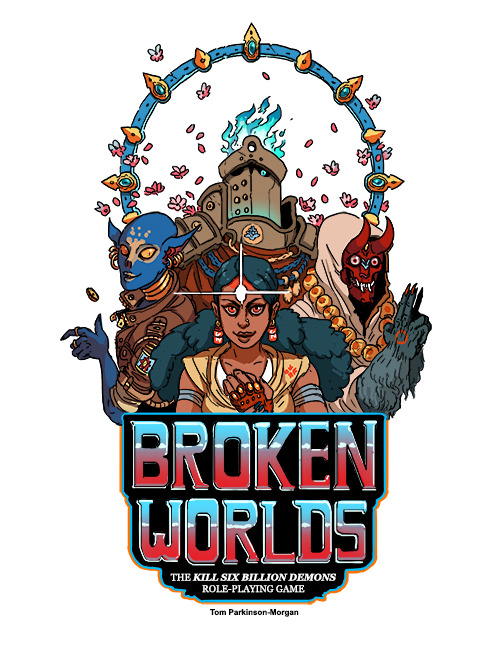
broken worlds is one of my favs bc of sheer vibes
Gubat Banwa didn't have much in that sense: sure, I use wuxia and xianxia as kind of guideposts, but they're not foundational, they're not pillars of the kind of fiction Gubat Banwa wants to raise up. there wasn't a lot in the sense of genre emulation or in the sense of grounding principles because so much of Gubat Banwa is built on stuff most TTRPG players haven't heard about. hell, it's stuff squirreled away in still being researched academic and anthropological circles, and thanks to the violence of colonialism, even fellow filipinos and seasians don't know about them
this is what brought me back to my ancient hyperfixations, the worlds of Exalted, Glorantha, Artesia, Fading Suns... all of them have these huge tomes of books that existed to put down this vast sprawling fantasy world, right? on top of that are the D&D campaign settings, the Dark Suns and the Eberrons. they were preoccupied in putting down setting, giving ways for people to interact with the world, and making the world alive as much as possible.
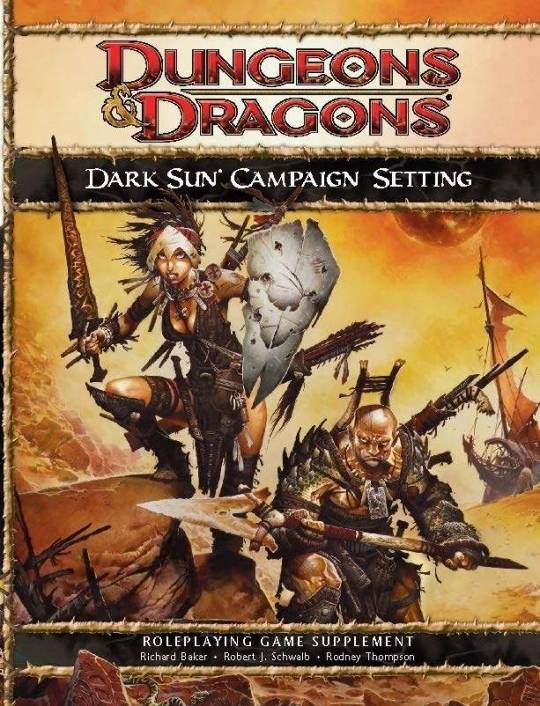
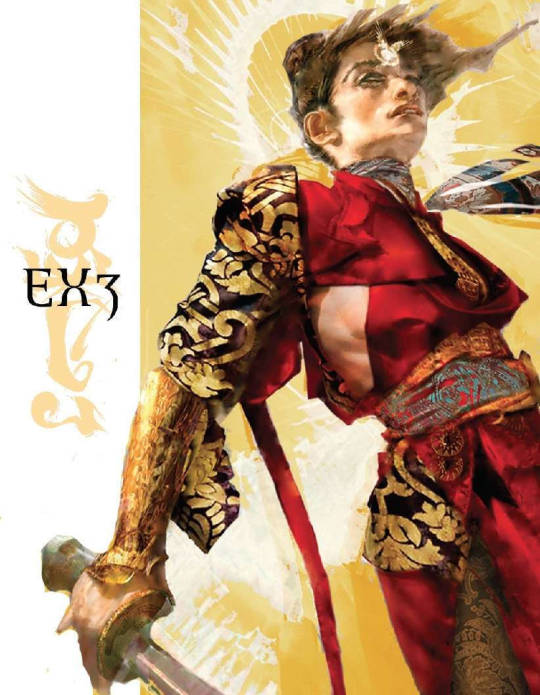
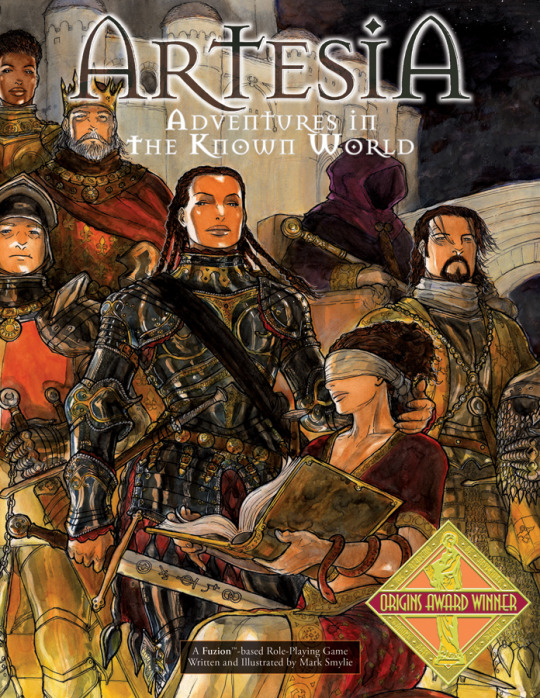
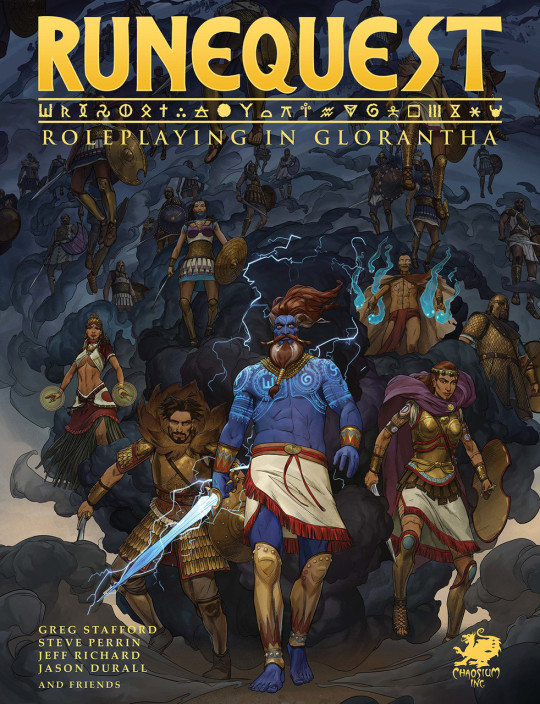
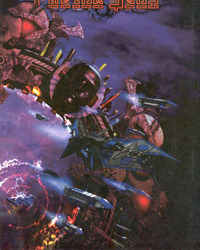
one of my main problems with gubat banwa was trying to convey this world that i've seen, glimpsed, dreamed of. this martial fantasy world of rajas and lakans, sailendras and tuns, satariyas and senapatis and panglimas and laksamanas and pandai... its a world that didn't really exist yet, and most references are steeped in either nationalism or lack of resources (slowly changing, now)

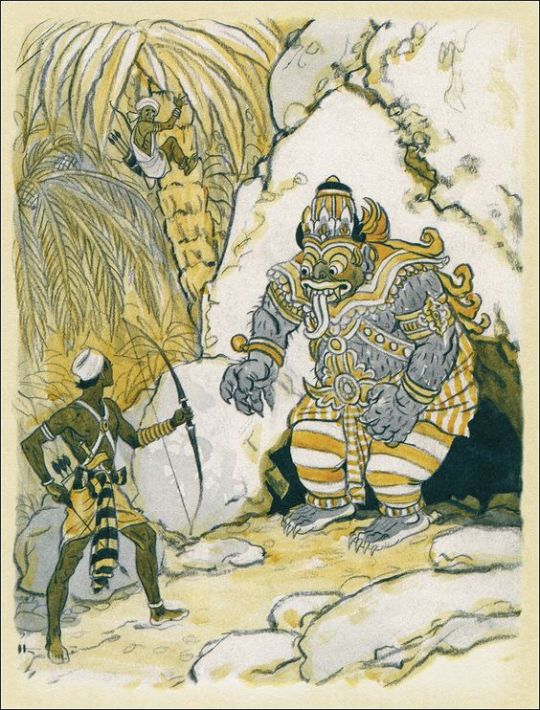
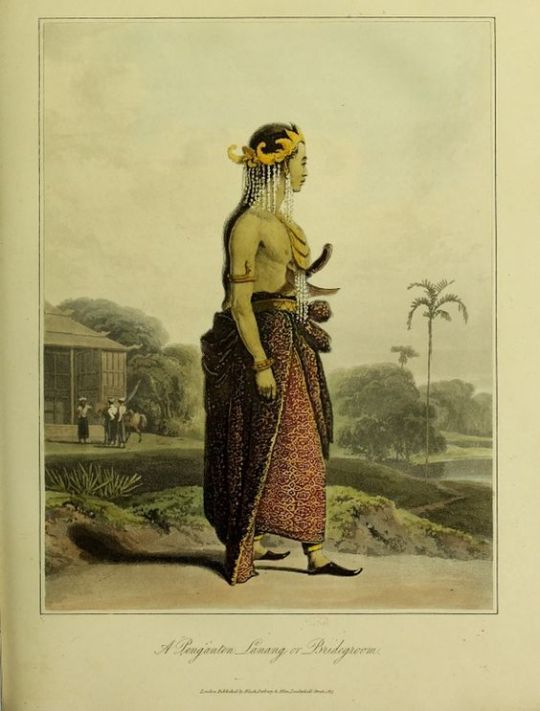
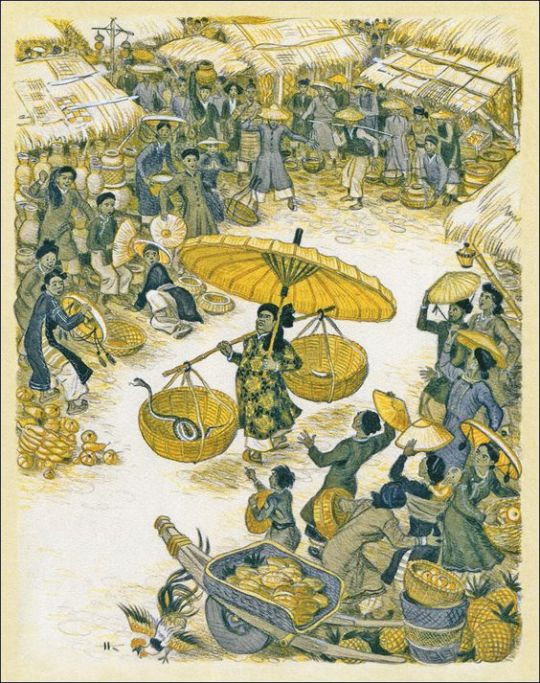
i didn't want to fall back into the whole gazeteer tourist kind of shit when it came to writing GB, but it necessitated that the primary guidelines of Gubat Banwa were set down. my approach to it was trying to instill every aspect of the text, from the systems to the fluff text to the way i wrote to the way things were phrased, with the essence of this world i'm trying to put forward. while i wrote GB mainly for me and fellow SEAsian people, economically my main market were those in the first world countries that could afford to buy the book. grokking the book was always going to be severely difficult for someone that didn't have similar cultures, or are uninterested in the complexities of human culture. thus why GB had to be a big book.
in contemporary indie ttrpg spaces (where I mostly float in, though i must admit i pay more attention to SEAsia spaces than the usual US spaces) the common opinion is that big books like Exalted 3e are old hat, or are somewhat inferior to games that can cram their text into short books. i used to be part of that camp--in capitalism, i never have enough time, after all. however, the books that do go big, that have no choice to go big, like Lancer RPG, Runequest, Mage, Exalted are usually the ones that have something really big it needs to tell you, and they might be able to perform the same amount of text-efficient bursting at the seams flavor writing but its still not enough.
thats what happened to GB, which I wanted to be, essentially, a PbtA+4e kind of experience, mechanically speaking. i very soon abandoned those titles when i delved deeper into research, incorporated actual 15th century divination tools in the mechanics, injected everything with Martial Arts flavor as we found our niche
all of this preamble to say that no matter how light i wanted to go with the game, i couldnt go too light or else people won't get it, or i might end up writing 1000 page long tome books explaining every detail of the setting so people get it right. this is why i went heavy on the vibes: its a ttrpg after all. its never gonna be finished.
i couldnt go too light because Gubat Banwa inherently exists on a different reality. think: to many 3 meals a day is the norm and the reality. you have to eat 3 meals a day to function properly. but this might just be a cultural norm of the majority culture, eventually co opted by capitalism to make it so that it can keep selling you things that are "breakfast food" or "dinner food" and whatnot. so its reality to some, while its not reality to others. of course, a lot of this reality-talk pertains mostly to social--there is often a singular shared physical reality we can usually experience*
Gubat Banwa has a different fabric of reality. it inherently has a different flow of things. water doesn't go down because of gravity, but because of the gods that make it move, for example. bad things happen to you because you weren't pious or you didn't do your rituals enough and now your whole community has to suffer. atoms aren't a thing in gb, thermodynamics isn't a real thing. the Laws of Gubat Banwa aren't these physical empirical things but these karmic consequent things
much of the fiction-first movement has a sort of "follow your common sense" mood to it. common sense (something also debatable among philosophers but i dont want to get into that) is mostly however tied to our physical and social realities. but GB is a fantasy world that inherently doesn't center those realities, it centers realities found in myth epics and folk tales and the margins of colonized "civilization", where lightnings can be summoned by oils and you will always get lost in the woods because you don't belong there.
so Gubat Banwa does almost triple duty: it must establish the world, it must establish the intended fiction that arises from that world, and then it must grant ways to enforce that fiction to retain immersion--these three are important to GB's game design because I believe that that game--if it is to not be a settler tourist bonanza--must force the player to contend with it and play with it within its own terms and its own rules. for SEAsians, there's not a lot of friction: we lived these terms and rules forever. don't whistle at night on a thursday, don't eat meat on Good Friday, clap your hands thrice after lighting an incense stick, don't make loud noise in the forests. we're born into that [social] reality
this is why fantasy is so important to me, it allows us to imagine a different reality. the reality (most of us) know right now (i say most of us because the reality in the provinces, the mountains, they're kinda different) is inherently informed by capitalist structures. many people that are angry at capitalist structures cannot fathom a world outside capitalist structures, there are even some leftists and communists that approach leftism and revolution through capitalism, which is inherently destructive (its what leads to reactionaries and liberalism after all). fantasy requires that you imagine something outside of right now. in essence read Ursula K Le Guin
i tweeted out recently that you could pretty easily play 15-16th century Luzon or Visayas with an OSR mechanic setting and William Henry Scott's BARANGAY: SIXTEENTH CENTURY PHILIPPINE CULTURE AND SOCIETY, and I think that's purely because barebones OSR mechanics stuff fits well with the raiding and adventuring that many did in 15-16th century Luzon/Visayas, but a lot of the mechanics wont be comign from OSR, but from Barangay, where you learn about the complicated marriage customs, the debt mechanics, the social classes and stratum...
so thats why GB needs to be a (relatively) big book, and why I can contend that some books need to be big as well--even if their mechanics are relatively easy and dont need more than that, the book, the game, might be trying to relay something even more, might be trying to convey something even more than that. artesia, for example, has its advancements inherently tied to its Tarot Cards, enforcing that the Arcana guides your destiny. runquest has its runes magic, mythras (which is kinda generic) has pretty specific kinds of magic systems that immediately inform the setting. this is why everything is informed by something (this is a common Buddhist principle, dependent arising). even the most generic D&D OSR game will have the trappings of the culture and norms of the one that wrote and worked on it. its written from their reality which might not necessarily be the one others experience. that's what lived experience is, after all
*live in the provinces for a while and you'll doubt this too!
389 notes
·
View notes
Note
With this whole 'rape fantasies are a result of misogyny as they allow women a guilt free sexuality cos they have no autonomy'
Surely that means your writing and fantasies are contributing to misogyny? Adding to it and normalising it?
Like isnt the answer to write and encourage fantasies of empowerment? Not abuse and rape?
Just seems crazy to me like 'we do this because of misogyny. And we'll keep doing it'
Obviously some behaviour come from misogyny and exist to combat it. This... really doesn't
I just don't think it's a feminist win when your writing is indistinguishable from that of a misogynistic man's.
This isnt an attack on you it just really seems like common sense that if something exists because of misogyny the last thing we should do is feed into those ideas
(I assume this is coming from this post, so I might reference that a bit here)
No worries, I fully understand how this can come across negative to those who do not have the same experiences and I appreciate you approaching the matter in a non-attacking way with genuine desire to have dialogue on the subject. I'll do my best to address these points individually.
>Surely that means your writing and fantasies are contributing to misogyny? Adding to it and normalising it?
In the past few years fandom culture has become a bit obsessed with the idea of "normalization" to the point that the definition of the term has been a bit skewed, which creates issues with these discussions.
There is no concept of which existence of content containing it alone constitutes normalization, by the actual definition of the word. Normalization is the process by which it is distributed and way in which it is presented, and intent of its creation.
Normalization via fiction is a process in which a creator, generally intentionally, creates content that presents a concept as, well, normal. That is, not reprehensible or problematic to replicate, and presents this to a population with the intent of them accepting the idea as something acceptable in reality. Generally it also necessitates that the creator will try to ensure the media is viewed by mainstream general audiences who would not normally seek the content out, since the purpose of normalization is to make an idea acceptable amongst a population.
That is the opposite of what I am doing, which is creating a private space filled with warnings. I am going out of my way to ensure that people who do not want to see this content, have the foreknowledge to opt to avoid it.
By definition, if you’re creating content and ensuring that it is heavily warned, and marketing it as such that only a niche group who likes such content seeks it out, that’s not normalization by any reasonable metric.
>Like isnt the answer to write and encourage fantasies of empowerment? Not abuse and rape?
For some people, I’m sure that would help them, and in that case, that is a great solution for them.
But people are different, and certain things that help some, don’t help others. The types of fantasies that would probably be called “empowering,” personally do nothing for me but make me uncomfortable, in the same way that the sort of content I write makes some people uncomfortable. It does not have the same positive effects on my mental health that this form of content does.
>Obviously some behaviour come from misogyny and exist to combat it. This... really doesn't
That's fair — but it doesn't have to.
It is not intended to directly combat misogyny in any way, there are other ways to do that, and this does not have to be one. It's primary purpose is catharsis and the ways in which it benefits me and, as is my hope, those who choose to consume it.
>I just don't think it's a feminist win when your writing is indistinguishable from that of a misogynistic man's.
Again, I never had any intention for it to be a "win" — misogyny is the reason for why I have these desires, but in making what I make, my purpose is to provide catharsis for myself and others.
But also, I would heavily contest that it is indistinguishable from male fantasies. As someone who has seen actual men's misogynist fetishization fantasies, they are very different.
Female disposability and the complete worthlessness of women’s very being — that is, women being non-human objects that are interchangeable, and made to be used temporarily and replaced — is the core defining characteristic of male fantasy/sexuality. Male fantasies almost always involve multiple women to one man, largely because he does not have any actual bond with women, they are items to be collected, no interpersonal relationship actually exists.
The lack of interpersonal connection and lack of personableness itself is fetishized by men, what men get off to is the power they feel from completely disregarding the woman as a person in any way. The very act of the woman being thrown away after being used is fetishized.
In male fantasy, there is no interpersonal connection or affection of any kind, whereas that is one of the defining themes of content like mine.
Tl;dr — while misogyny impacts all women, the severity and form of it in different upbringings, environments and cultures can create misunderstandings and strong reactions when different people react so differently to the same content and thus form misconceptions about each other's perceptions and intentions, but I believe both sides of this argument are usually coming from a place of good intent.
While I fully understand how it would be difficult for those who do not have the same experience to grasp mine, I just ask for mutual understanding that some forms of content help some people, in the same way entirely different forms of content help other people.
178 notes
·
View notes
Note
Hi! As someone that got intrestered in F1 3 months ago, I am curious what the deal is between Lando and Charles? Why would you say that he hates him lol
Lando and Charles are like those two people who have exactly the same mutual friends and try and force a friendship for the sake of those friends but at the end of the day they just don't really get along at all.....
The long and (mostly) short of it all is that they were close in lockdown along with George and Alex, although even then it was a bit weird because George and Alex were Charles' friends first (the three of them have a gc together that dates back about a decade), but Lando/George/Alex had been pushed together a lot the previous year in 2019 since they were all young and marketable rookies. That just creates a weird dynamic as is. I can't speak on 2020-2023 but in 2024 there was a whole weird thing with the way Lando and Charles' contracts were each announced, in which Charles announced his and then Lando announced his literally the day after but whereas Charles' was planned Lando's seemed rushed. In hindsight it could've been due to the Lewis to Ferrari news somehow starting to leak (this was all a week before) but there was also a couple of weird media back and forths in which Lando said he wouldn't want to go to Red Bull because he doesn't want to match up against a prime Max, and then Charles says pretty soon later that he would 100% match up against Max, and all in all it's a little "was that a jab or???" coming from all sides re: their media quotes. I'm definitely forgetting some but that's the gist of it.
All in all as well I think they both generally see each other as a potential threat to each other's 'brands' so to speak. They both want to be the young blazing talent in F1 who will match up to and eventually overthrow the Max Verstappen dominance. They both also have similar niches of fans, that is the traditional die-hard fans of their respective teams and this massive young audience which exists primarily online. They ultimately are quite different people and see each other as a threat. Maybe they should work it out on the remix.
Re: why I was saying something was off in the first place, Lando in the latest GTG referred to Charles by his surname which he only did for drivers he isn't close to.
115 notes
·
View notes
Text
The Expansive World of Altcoins: Exploring the Diversity Beyond Bitcoin

Bitcoin, the original cryptocurrency, has long dominated headlines and market discussions. However, the world of digital currencies is vast and diverse, with thousands of alternative coins, or altcoins, each offering unique features and value propositions. Altcoins encompass a broad range of projects, from utility tokens and stablecoins to meme coins and more. This article delves into the rich ecosystem of altcoins, highlighting their significance, various types, and the innovative projects that make up this vibrant space, including a mention of Sexy Meme Coin.
Understanding Altcoins
The term "altcoin" refers to any cryptocurrency that is not Bitcoin. These coins were developed to address various limitations of Bitcoin or to introduce new features and use cases. Altcoins have proliferated since the creation of Bitcoin in 2009, each aiming to offer something different, whether it be improved transaction speeds, enhanced privacy features, or specific utility within certain ecosystems.
Categories of Altcoins
Utility Tokens: Utility tokens provide users with access to a specific product or service within a blockchain ecosystem. Examples include Ethereum's Ether (ETH), which is used to power applications on the Ethereum network, and Chainlink's LINK, which is used to pay for services on the Chainlink decentralized oracle network.
Stablecoins: Stablecoins are designed to maintain a stable value by being pegged to a reserve of assets, such as fiat currency or commodities. Tether (USDT) and USD Coin (USDC) are popular stablecoins pegged to the US dollar, offering the benefits of cryptocurrency without the volatility.
Security Tokens: Security tokens represent ownership in a real-world asset, such as shares in a company or real estate. They are subject to regulatory oversight and are often seen as a bridge between traditional finance and the blockchain world.
Meme Coins: Meme coins are a playful and often humorous take on cryptocurrency, inspired by internet memes and cultural trends. While they may start as jokes, some have gained significant value and community support. Dogecoin is the most famous example, but many others, like Shiba Inu and Sexy Meme Coin, have also captured the public's imagination.
Privacy Coins: Privacy coins focus on providing enhanced privacy features for transactions. Monero (XMR) and Zcash (ZEC) are notable examples, offering users the ability to transact anonymously and protect their financial privacy.
The Appeal of Altcoins
Altcoins offer several advantages over Bitcoin, including:
Innovation: Many altcoins introduce new technologies and features, driving innovation within the cryptocurrency space. For example, Ethereum introduced smart contracts, enabling decentralized applications (DApps) and decentralized finance (DeFi) platforms.
Specialization: Altcoins often serve specific niches or industries, providing targeted solutions that Bitcoin cannot. For instance, Ripple (XRP) focuses on facilitating cross-border payments, while Filecoin (FIL) aims to create a decentralized storage network.
Investment Opportunities: The diverse range of altcoins presents numerous investment opportunities. Investors can diversify their portfolios by investing in projects with different use cases and growth potentials.
Notable Altcoins in the Market
Ethereum (ETH): Ethereum is the second-largest cryptocurrency by market capitalization and has become the backbone of the DeFi and NFT (Non-Fungible Token) ecosystems. Its smart contract functionality allows developers to create decentralized applications, leading to a thriving ecosystem of financial services, games, and more.
Cardano (ADA): Cardano is a blockchain platform focused on sustainability, scalability, and transparency. It uses a proof-of-stake consensus mechanism, which is more energy-efficient than Bitcoin's proof-of-work. Cardano aims to provide a more secure and scalable infrastructure for the development of decentralized applications.
Polkadot (DOT): Polkadot is designed to enable different blockchains to interoperate and share information. Its unique architecture allows for the creation of "parachains," which can operate independently while still benefiting from the security and connectivity of the Polkadot network.
Chainlink (LINK): Chainlink is a decentralized oracle network that provides real-world data to smart contracts on the blockchain. This functionality is crucial for the operation of many DeFi applications, making Chainlink a vital component of the blockchain ecosystem.
Sexy Meme Coin: Among the meme coins, Sexy Meme Coin stands out for its combination of humor and innovative tokenomics. It offers a decentralized marketplace where users can buy, sell, and trade memes as NFTs (Non-Fungible Tokens), rewarding creators for their originality. Learn more about Sexy Meme Coin at Sexy Meme Coin.
The Future of Altcoins
The future of altcoins looks promising, with continuous innovation and increasing adoption across various industries. As blockchain technology evolves, we can expect altcoins to introduce new solutions and disrupt traditional systems. However, the market is also highly competitive, and not all projects will succeed. Investors should conduct thorough research and due diligence before investing in any altcoin.
Conclusion
Altcoins represent a dynamic and diverse segment of the cryptocurrency market. From utility tokens and stablecoins to meme coins and privacy coins, each category offers unique features and potential benefits. Projects like Ethereum, Cardano, Polkadot, and Chainlink are leading the way in innovation, while niche coins like Sexy Meme Coin add a layer of cultural relevance and community engagement. As the cryptocurrency ecosystem continues to grow, altcoins will play a crucial role in shaping the future of digital finance and blockchain technology.
For those interested in the playful and innovative side of the altcoin market, Sexy Meme Coin offers a unique and entertaining platform. Visit Sexy Meme Coin to explore this exciting project and join the community.
107 notes
·
View notes
Text
It's all connected. Corporations began marketing gay pride themed merchandise. An increase in "I-identify-as" populations began to flood gay bars and events, where outward appearance (marketed as "gender expression") became heavily emphasized.
Commercial visibility and marketability does not equal human rights progress.
Ability to consume does not equal citizenship to an oppressed group.
Biology, (referring to sexual orientation and sex) is not a brand you can buy into or boycott out of.
Corporations selling rainbows do not reflect our values.
The churning out of new "all inclusive" pride flags to pledge allegiance to is not indicative of liberation.
A historical homosexual slur being sold by the multi-billion dollar media obfuscates predominantly lesbian relationships ("queer women", "queer relationship") and retraumatizes many gay and lesbian people.
Gay pride only extending to people able to purchase detracts from the meaning of gay pride and distracts from the struggles of the most vulnerable. It positions the most privileged within marginalized and oppressed groups as those who represent the whole.
And associating body modification, aestheticism, and "expression" with self identity turns the lived experiences and material realities of entire subgroups of people into niche market categories that people who aren't even a part of these groups can identify into and out of based on social trends.
Biology becomes devalued, overshadowed by the social and manufactured "genders". Infinite genders means infinite target audiences. Lived, material realities of certain groups of people become materialism.
Human rights movements are becoming human rights industries, with the wealthy more directly capitalizing off of the exploitation of the poor, of the homosexual, of the female, of the immigrant, of the dark skinned, of the mentally ill, of the disabled, of the sick, of the marginalized and oppressed.
Don't buy into it.
#tangent#LGB#LGBT#gay rights#gender#gender critical#gender norms#gay pride#pride flag#lgbt pride#queer#q slur#queer identity#identity#identity coining#feminism#anti capitalism#woke homophobia#consumerism#capitalism#corporations
1K notes
·
View notes
Text
I'm always fascinated when someone at the club rants about "how they just invented T'au to cash on them anime weebs", completly oblivious to the time and culture of their creation. So T'au came out first in 2001, and were obviously conceptualized some years prior, which puts them into the late 90s in their original design. This is slowly hitting "the majority of the populance has no relevant internet access whatsoever" levels of "barbaric analog ages".
So imagine where GW sits in the late 90s - its a small studio somewhere in England barely coming to touch with the first elements of the internet, with the most dominant medium being television which... is not really about "exotic" shows from the other end of the world? Those get ported over when they have proven to be a hit in their own country mostly.
And without the internet as we know it today, the anime community just... did not exist. You have to understand that the whole concept of online anime culture centred around piracy, fansubs, fanart, and the creation of the term "weeabo" was a mid-to-late 00s thing, and it took almost another decade before "weeb" was somewhat reclaimed and no longer an online-slur.
There was a whole generation that grew up with (often horribly localized) japanese shows on TV (Pokemon, Dragon Ball, Sailor Moon) which came over with some delay to their release in Japan. By the time this generation came to congregate into online spaces and form any sort of fan-identity and culture, the T'au and their battlesuits had already been a design over a decade old.
"But wait isn't Gundam from the 70s"? Yes, that is totally correct. However, this is the one glaring mistake people make: you cannot compare modern day media content circulation around the globe to the analog ages. Those of us who remember these barbaric analog times know how it was: you just did not know stuff existed. If it was not in the newspaper or on the telly, it might as well not exist unless you knew a guy who knew a guy who knew a guy.
Sure, the Internet was slowly becoming a thing that found widespread use, but it would still take a while - not to mention the technical limitations. No streaming episodes. You start the download (if you can find someone who hosted the file of a series you had to know even existed first) somewhere around lunch, to hopefully get something to watch in the afternoon. Oh and also that blocked the household's phone-line and if the download cancelled for whatever reason then it was back to square one. Under such conditions, the online community we know today could simply not exist, as the alternative was importing stuff from the other end of the world for quite the money, or hoping a really shoddy localized VCR-tape ended up at your Blockbuster-equivalent.
Of course there was anime before that time, even those regarded absolute classics in the west, but those mostly achieved that rank over here in retrospective. When in the late 00s people wanted to watch stuff and had the ability to do so they shared what was considered "the classics" first (shared to the best of their ability with one episode cut into 5 parts on youtube with sometimes very questionable subtitles).
So even if we assume there was someone at GW in the 90s who was a total "proto-weeb" and Gudam-fan, there was literally no reason to "make knock-off Gundams" because the miniscule western wargaming audience SIMPLY DID NOT KNOW THE STUFF.
You can't make a marketing ploy to reference something your average consumers have never heard off. If anything, the creation of the T'au as a robotic-centred faction was inevitable: they needed a design that could hold their own in the setting, but Necrons hogged the full-robot niche, Imperials were weird cyborgs, Orks the "madman-scrap-tech", and Nids the "biotech". The only thing left here was "not full robot but also very clean and efficient" - and just like that, the Battlesuits and Drones were born.
It was only in later years when the Internet had come into full swing where they decided to go full-suit with releases such as the Riptide, but if we talk about the OG design of T'au and the first decade? Nothing to do with anime or "fishing for weebs". The fish would not be coming to that spot for almost a decade, and it would take a bit more before their numbers were plentyful enough to make it worth casting a line out.
454 notes
·
View notes
Text
Keroro Files No.046 - No.066
(more english translated files for the characters in "Keroro Gunso the Super Movie: Gekishin Dragon Warriors de arimasu!")
This section goes over the 2nd, 3rd, and 4th movie along with Chibi Kero episodes (so perhaps a spoiler warning if that’s any important)




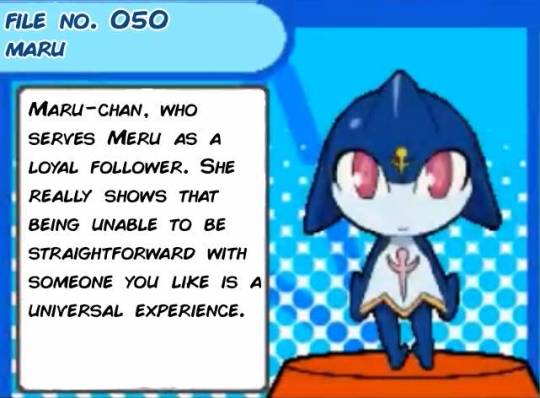

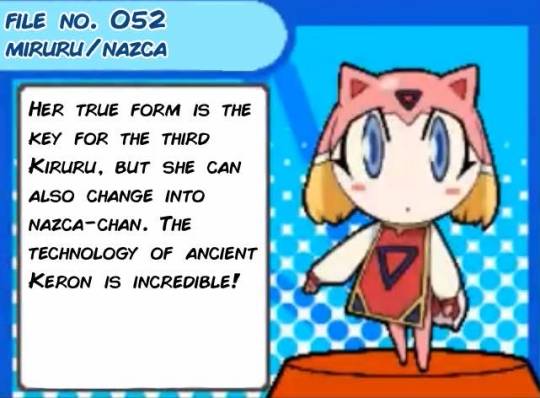
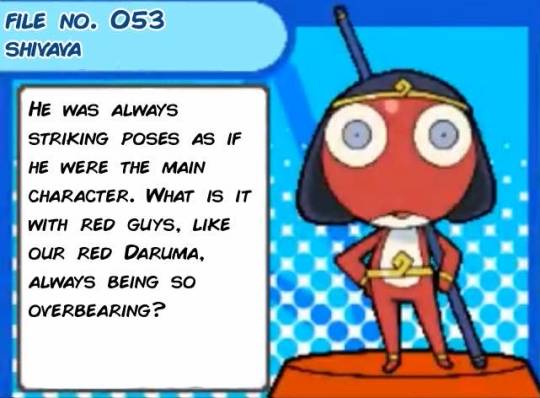
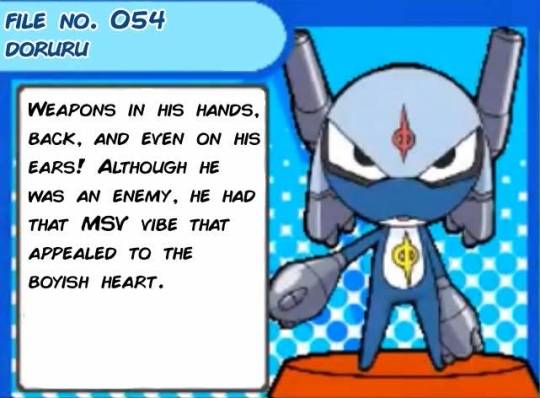

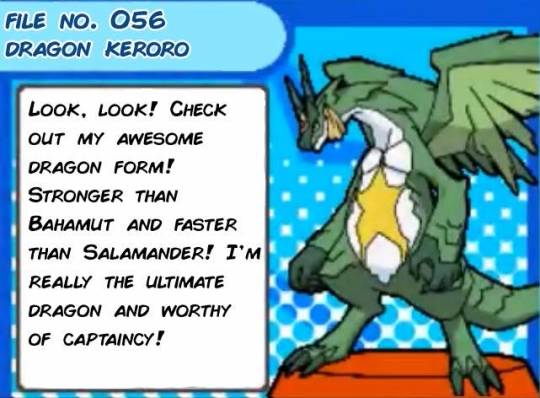
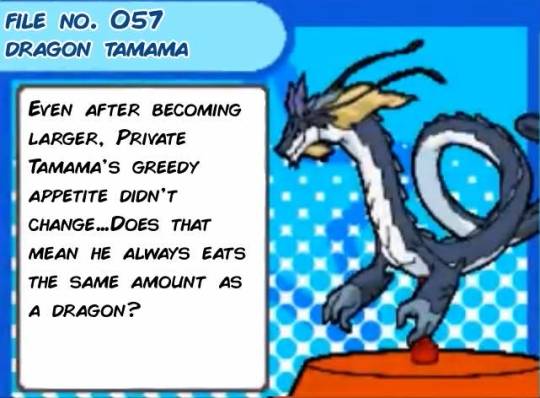
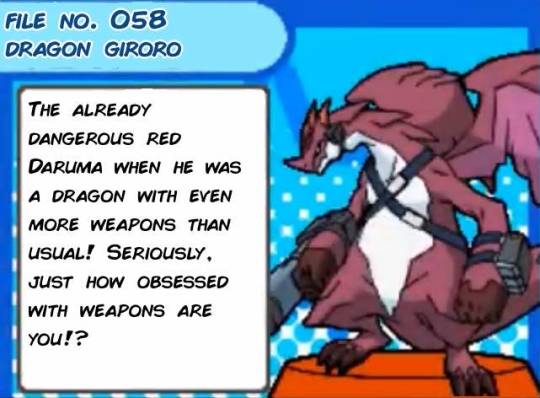


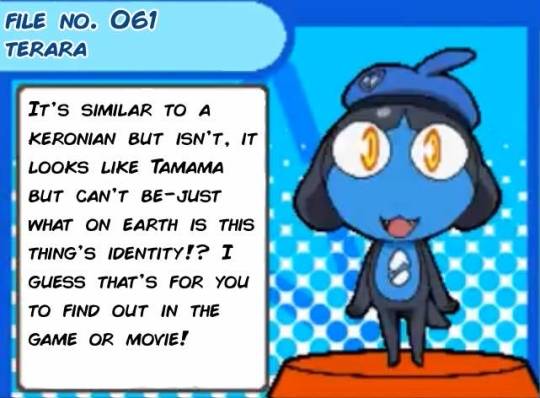



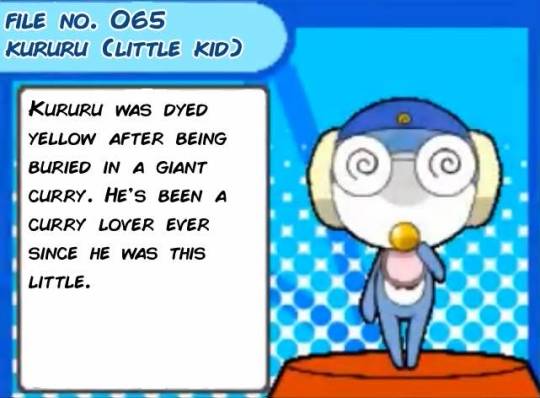
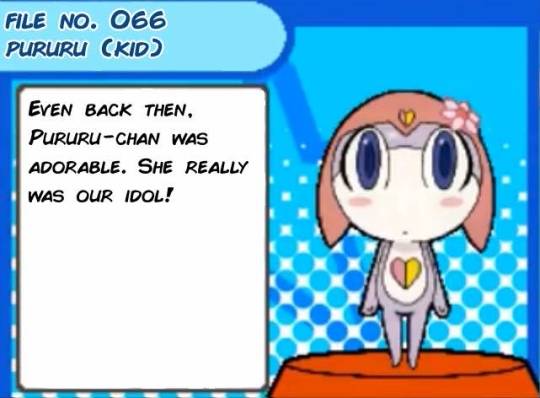
Some Additional Notes:
We’re getting into the more niche criteria here with movie-specific ones; I promise if you guys don’t know who the majority of the characters on here are it doesn’t matter whatsoever. There’s 101 files in total so there will probably be about two more posts of this…. only gets more niche from here ❤️
File No.51: Keroro just saying it’s sad that dkeroro doesn’t know what gundam is is INSANE 😭😭
File No.53: “Red Daruma” is a nickname for Giroro which is basically just a red wishing doll (along with keroro racially stereotyping keronians as always)
File No.54: MSV stands for “Mobile Suit Variation.” it was a design series unsurprisingly
File No.56 Bahamut and Salamander are NOT Gundam references (shocking, I know). They’re just mythical creatures/dragons
File No.61: Since this game came out a little before the 4th movie dropped, Terara’s existence was still kinda just “????” + marketing strat by keeping it spoiler safe
File No.62: Another Gundam reference but I cannot emphasize enough how much Keroro is NOT Amuro Ray 😭🙏
File No.65: This sounds INSANE without any real context; Keroro is leaving out the fact that it was an accident with the keroball and that it was HIS fault
—And as always another plug to Soroaxas since I got all of the original files from their bonus video‼️
#these all seem fucking insane with no context#i can only do so much for the non-brainrotted kg fans…💔#keroro is the definition of a nonreliable narrator#keroro gunso#sgt frog#keroro gunso the super movie
65 notes
·
View notes